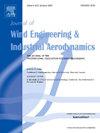Field measurement study on typhoon wind characteristics during strong wind periods
IF 4.9
2区 工程技术
Q1 ENGINEERING, CIVIL
Journal of Wind Engineering and Industrial Aerodynamics
Pub Date : 2025-07-04
DOI:10.1016/j.jweia.2025.106158
引用次数: 0
Abstract
Based on the wind records of seven typhoons observed from 356-m-high Shenzhen Meteorological Gradient Tower (SZMGT) between 2017 and 2023, the differences and similarities of wind characteristics during strong wind periods for these typhoons are explored. The wind parameters, involving mean wind profile, turbulence intensity, turbulence integral scale, as well as gust and peak factors are presented and discussed. Moreover, Gaussianity, vertical coherence, and power spectral density are investigated. The results indicate that the strongest 10-min wind profiles for seven typhoons generally align with those recommended in codes and standards for suburban terrain at SZMGT, while the observed turbulence intensities during typhoons are markedly larger than those given for suburban terrain. The dispersion of turbulence integral scales for different typhoon events is more pronounced than that of turbulence intensity, however, a good consistency is observed in gust factors for seven typhoons. Compared with the Solari spectrum, the von Kármán spectrum can better describe the observed power spectra of longitudinal/lateral/vertical fluctuating wind speeds during strong wind periods. Furthermore, the fluctuating wind speeds overall show reasonable agreement with the Gaussian distribution. The outcome of this study is expected to provide a useful reference for wind-resistant design of building structures in typhoon regions.
强风期台风风特征的野外测量研究
利用深圳气象梯度塔(SZMGT) 2017—2023年7次台风的风场记录,分析了7次台风强风期风场特征的异同。给出并讨论了平均风廓线、湍流强度、湍流积分尺度、阵风因子和峰值因子等风参数。此外,还研究了高斯性、垂直相干性和功率谱密度。结果表明,7个台风的10分钟最强风廓线与SZMGT郊区地形规范和标准推荐的10分钟最强风廓线基本一致,而台风期间的湍流强度明显大于郊区地形。不同台风事件的湍流积分尺度的弥散比湍流强度弥散更明显,但7个台风的阵风因子具有较好的一致性。与Solari谱相比,von Kármán谱能更好地描述强风期纵/横/垂直波动风速的观测功率谱。脉动风速总体上符合高斯分布规律。研究结果可为台风地区建筑结构的抗风设计提供有益的参考。
本文章由计算机程序翻译,如有差异,请以英文原文为准。
求助全文
约1分钟内获得全文
求助全文
来源期刊
CiteScore
8.90
自引率
22.90%
发文量
306
审稿时长
4.4 months
期刊介绍:
The objective of the journal is to provide a means for the publication and interchange of information, on an international basis, on all those aspects of wind engineering that are included in the activities of the International Association for Wind Engineering http://www.iawe.org/. These are: social and economic impact of wind effects; wind characteristics and structure, local wind environments, wind loads and structural response, diffusion, pollutant dispersion and matter transport, wind effects on building heat loss and ventilation, wind effects on transport systems, aerodynamic aspects of wind energy generation, and codification of wind effects.
Papers on these subjects describing full-scale measurements, wind-tunnel simulation studies, computational or theoretical methods are published, as well as papers dealing with the development of techniques and apparatus for wind engineering experiments.

 求助内容:
求助内容: 应助结果提醒方式:
应助结果提醒方式:


